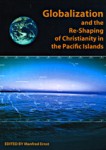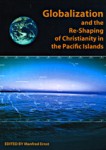 On July 13th of this year, the Fijian Vice-President participated at the Pacific Theological College in the official launch of a collective book edited by Manfred Ernst, Globalization and the Re-shaping of Christianity in the Pacific Islands, dealing with the contemporary changes of Christianity in Oceania: Mormon and Adventist Churches taking root, declining Historical Protestant Churches and rapidly growing Evangelicals and Pentecostals.
On July 13th of this year, the Fijian Vice-President participated at the Pacific Theological College in the official launch of a collective book edited by Manfred Ernst, Globalization and the Re-shaping of Christianity in the Pacific Islands, dealing with the contemporary changes of Christianity in Oceania: Mormon and Adventist Churches taking root, declining Historical Protestant Churches and rapidly growing Evangelicals and Pentecostals.
In 1994, M. Ernst published a first study, Winds of Change, a project founded by the Pacific Conference of Churches that gathers Catholic, Historical Protestant and Anglican Churches in Oceania. The heads of these churches wanted to get information and analysis in order to understand and foil what they saw as an invasion of “foreign” (and more specifically American) Churches and beliefs. Despite some arguable points (notably the supposedly impossible conciliation between “community” local Christian cultures and movements described as “individualists”), Winds of Change became a major reference for those interested in the study of contemporary Christianity in Oceania. The very expected book launched in July will certainly be an even more precious source of information and analysis. Ten years after, it draws up a new inventory, once again with the support of the Pacific Conference of Churches. During these ten years, the “new” churches have deeply taken root in the Oceania religious landscape and it has become more and more difficult to think that they still have “nothing to do” with the local cultures and societies. So we need to understand in what extent they go with and/or contribute to social and cultural changes experienced by the Oceania Islands, how they articulate local specificities and a religious globalisation. The heads of the Historical Churches now understand that these “new” Churches compensate for many of their own deficiencies: too hierarchical structures of authority controlled by the old generation, small part given to the youth in the making of decision, an obsolete rigorism left by the missionaries (dresses, music, role of women), a discourse focused on the inherited belonging to an ethnic-cultural community rather than on individual needs, etc. To dream on the “good old time” coming back is vain, the time when these churches organised the religious and social life of Oceania populations and the urgent task is now to think on the main challenge of the next years: the modalities of religious pluralism. The second part of the book is made of detailed case studies of the religious landscape in 14 Pacific countries, Gwendoline Malogne-Fer and I wrote the chapter on French Polynesia. The book can be notably purchased on the website of the USP (University of the South Pacific) or with an order form.
globalisation
-
The New Face of Christianity in Oceania: A Major Reference
-
Le nouveau visage du christianisme océanien : un ouvrage collectif incontournable
 Le vice-président de l’État fidjien a participé le 13 juillet 2006, au Pacific Theological College de Suva, au lancement officiel d’un ouvrage collectif coordonné par Manfred Ernst et intitulé Globalization and the Re-shaping of Christianity in the Pacific Islands, consacré aux évolutions contemporaines du christianisme en Océanie : consolidation des églises mormones et adventistes, déclin des églises protestantes historiques, rapide progression des mouvements évangéliques et pentecôtistes.
Le vice-président de l’État fidjien a participé le 13 juillet 2006, au Pacific Theological College de Suva, au lancement officiel d’un ouvrage collectif coordonné par Manfred Ernst et intitulé Globalization and the Re-shaping of Christianity in the Pacific Islands, consacré aux évolutions contemporaines du christianisme en Océanie : consolidation des églises mormones et adventistes, déclin des églises protestantes historiques, rapide progression des mouvements évangéliques et pentecôtistes.
En 1994, M. Ernst avait publié une première étude, Winds of Change, un projet financé par la Pacific Conference of Churches qui rassemble les églises historiques d’Océanie, catholiques et protestantes. Les responsables de ces églises souhaitaient alors se donner les moyens de faire face à ces transformations, souvent perçues par eux comme une invasion d’églises et de croyances « étrangères », plus précisément nord-américaines. En dépit d’analyses parfois discutables des « nouveaux groupes religieux » (fondées notamment sur l’idée d’une incompatibilité irréductible entre les cultures chrétiennes locales « communautaires » et des mouvements décrits comme « individualistes »), Winds of Change est rapidement devenu une référence incontournable pour tous ceux qui s’intéressent au christianisme contemporain en Océanie.
Le livre lancé le 13 juillet dernier, très attendu, constituera certainement une ressource documentaire et analytique encore plus précieuse. Il dresse, près de dix ans plus tard, un nouvel état des lieux, encore une fois grâce au financement de la Pacific Conference of Churches. Depuis, les « nouvelles » églises se sont solidement implantées dans le paysage religieux océanien et il devient chaque jour plus difficile de prétendre qu’elles n’ont « rien à voir » avec les cultures et les sociétés locales. Il faut donc s’attacher à comprendre en quoi elles accompagnent et/ou amplifient les changements sociaux et culturels que connaissent les îles océaniennes, comment elles articulent la prise en compte des spécificités locales avec une « globalisation » religieuse débordant le seul cadre régional. Les responsables des églises historiques ont aujourd’hui compris que ces « nouvelles » églises pallient bon nombre de leurs propres déficiences : modèles d’autorité trop hiérarchiques et gérontocratiques, faible intégration des jeunes aux instances de décision, maintien d’un rigorisme hérité des missionnaires (tenues vestimentaires, musique, place des femmes), discours axé sur l’appartenance héritée à une communauté ethnico-culturelle plutôt que sur les besoins individuels, etc. Et il est sans doute vain d’espérer revenir au « bon vieux temps » où ces églises organisaient à elles seules la vie religieuse et sociale des populations océaniennes, mieux vaudrait réfléchir dès maintenant au principal défi des années à venir : les modalités de gestion du pluralisme religieux. La seconde partie du livre comprend des études détaillées de la situation religieuse dans quatorze pays du Pacifique, dont une consacrée à la Polynésie française, que j’ai écrite en collaboration avec Gwendoline Malogne-Fer. Le livre est en vente sur le site Internet de l'University of South Pacific et devrait être prochainement disponible sur les sites du type amazon.com. Il peut également être commandé en renvoyant un bon de commande.(Photo haut : un des bâtiments du Pacific Theological College)
océaniennes, comment elles articulent la prise en compte des spécificités locales avec une « globalisation » religieuse débordant le seul cadre régional. Les responsables des églises historiques ont aujourd’hui compris que ces « nouvelles » églises pallient bon nombre de leurs propres déficiences : modèles d’autorité trop hiérarchiques et gérontocratiques, faible intégration des jeunes aux instances de décision, maintien d’un rigorisme hérité des missionnaires (tenues vestimentaires, musique, place des femmes), discours axé sur l’appartenance héritée à une communauté ethnico-culturelle plutôt que sur les besoins individuels, etc. Et il est sans doute vain d’espérer revenir au « bon vieux temps » où ces églises organisaient à elles seules la vie religieuse et sociale des populations océaniennes, mieux vaudrait réfléchir dès maintenant au principal défi des années à venir : les modalités de gestion du pluralisme religieux. La seconde partie du livre comprend des études détaillées de la situation religieuse dans quatorze pays du Pacifique, dont une consacrée à la Polynésie française, que j’ai écrite en collaboration avec Gwendoline Malogne-Fer. Le livre est en vente sur le site Internet de l'University of South Pacific et devrait être prochainement disponible sur les sites du type amazon.com. Il peut également être commandé en renvoyant un bon de commande.(Photo haut : un des bâtiments du Pacific Theological College)